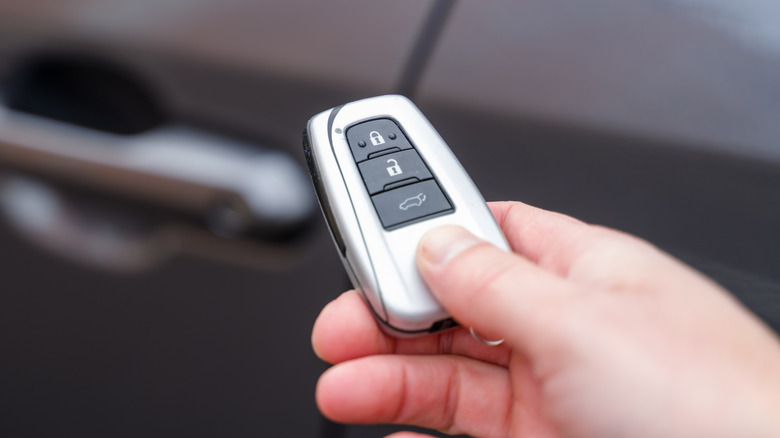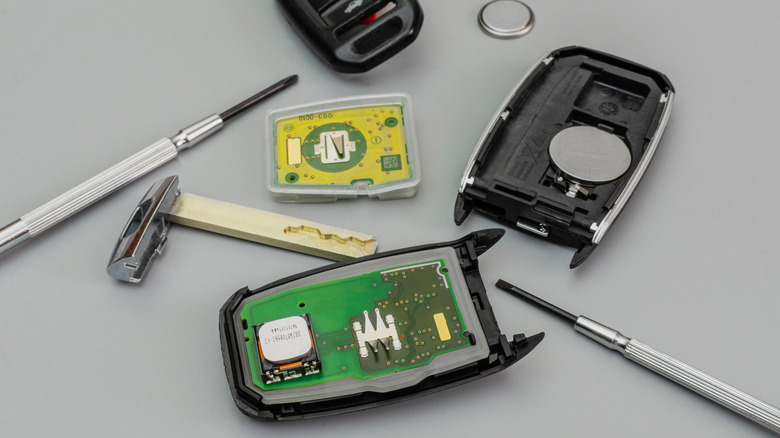Don't Get Locked Out: How To Spot A Dying Key Fob Battery Before It's Too Late
Long gone are the days of having to use an actual key to unlock your car doors. Modern vehicles typically come with a remote key fob — a term with an interesting backstory — allowing you to lock and unlock your doors, sound a warning alarm, and more from a distance. As convenient as they can be, though, they could become a nuisance over time. As a small remote, it relies on a battery, and a dead battery can leave you without a means of unlocking your doors. As such, it's crucial to know the warning signs that your key fob's battery is on its last legs.
The clearest sign that a key fob battery needs to be replaced is how the fob responds, or how it doesn't, when buttons are pressed. If your fob takes unusually long to respond to button presses, or doesn't respond at first press, the battery is probably in need of replacement. Similarly, if you're only able to get the fob to function when you're in close proximity to your car, it's likely lacking the power to work as normal. The fob may also have enough reach to lock or unlock your car, but not enough strength to cause the headlights to flash simultaneously.
How to replace a key fob battery
There are a lot of DIY tasks one can do on their car's engine, exterior and interior, and associated accessories, and a key fob battery replacement is one of the simplest. It shouldn't require any tools, aside from maybe a small flathead screwdriver to open it, and, naturally, a replacement battery. Most fobs take a small CR2032 coin cell battery, though you should know that this could vary depending on the car in question.
- Your key fob should have a small notch somewhere along the edge. Find it and, using your nail or a small tool, pop the fob open.
- Pull the two halves apart and remove the old battery. Make a note of its orientation inside the fob.
- Install the new battery correctly and snap the fob halves back together.
- Test all of the buttons on the fob to make sure the battery replacement worked.
In a best-case scenario, it won't take any more than this to have your key fob working at its best once again. However, this is a piece of modern technology, after all. That means other issues can present themselves, rendering a battery swap useless should things get severe enough elsewhere.
Issues with key fobs beyond a dead battery
If a battery replacement hasn't solved your key fob woes, there could be several different issues at hand. The battery could be installed incorrectly, so it's worth trying to flip it first. You should also check that the battery contacts are clean so the battery can actually deliver power to the rest of the fob. If this doesn't work, the buttons could be to blame. The buttons and the contacts beneath them can wear out over time, preventing them from sending a strong signal to the car when pressed. Unfortunately, this means a full or partial fob replacement is in order.
Then again, the condition of the fob might not be to blame after all. There could be a bigger communication issue between the fob and your vehicle. There's a chance that, somehow, the fob may have been deprogrammed at some point, eliminating any memory of the fob from the vehicle's computer. You can try to find a way to reprogram it, though key fob reprogramming does take some time, so you may need help from your dealership or a mechanic. Alternatively, if you find the fob only works on some doors or for some functions, there could be a mechanical issue with the car. Perhaps a lock or latch is broken and needs to be repaired for the fob to be of any assistance.
Cars can present all kinds of challenges, some big and some small. More often than not, key fob issues fall into the latter category with just a bad battery to blame. Sometimes, though, there's more to the story that a mechanic may need to address.


